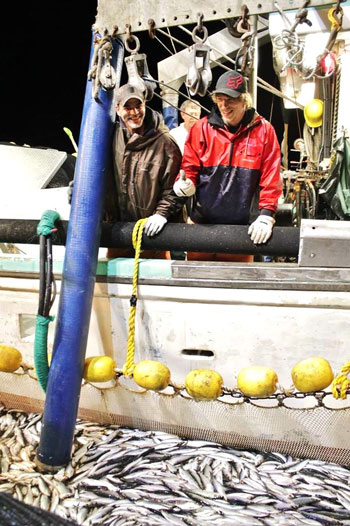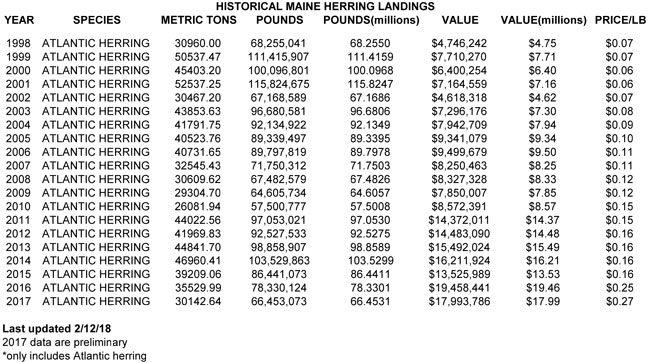Herring Assessment Sets Off
Alarm Bells
by Laurie Schreiber

Pumping herring into a carrier vessel. “It’s a matter of getting it (survey) done in the time allowed with the amount of money available.” – James Weinberg, NEFSC. Joel Woods photo.
PLYMOUTH, Mass.—Although Atlantic herring is not overfished and overfishing is not occurring, a panel of stock assessment experts have determined that the prognosis for the resource is poor for the coming years due to low recruitment.
So the panel’s recommendation to fishery managers, in their most recent stock assessment, was that, even though no action seems to be required, it would be appropriate to consider new controls on fishing.
James Weinberg, with the Northeast Fisheries Science Center (NEFSC) in Woods Hole, Mass., reported to the New England Fishery Management Council (NEFMC) at its September meeting on the Northeast Regional Stock Assessment Workshop (SAW) in June that arrived at that conclusion.
“Recruitment” the number of fish surviving to enter the fishery or to a life history stage.
The Northeast Regional Stock Assessment Workshop is a formal scientific peer-review process for evaluating and presenting stock assessment results to managers for fish stocks in the offshore U.S. waters of the northwest Atlantic, according to information on the NEFSC website. Assessments are prepared by SAW working groups and reviewed by an independent panel of stock assessment experts called the Stock Assessment Review Committee, or SARC. Weinberg is chairman of the SAW/SARC process.
At NEFMC’s meeting, NEFMC Executive Director Tom Nies said that peer reviews don’t typically offer opinions on regulatory matters, which are NEFMC’s purview.
“I’m concerned that the peer review of the SARC seems to be wandering into management issues, which they’re not convened to address,” Nies said. “It’s not that I think this is a bad idea, but it’s not really what a peer review is tasked to do.”
“I don’t think they strayed too far,” responded Weinberg. “They were just thinking ahead about what might come next. But your point is taken.”
According to a NEFMC press release, the assessment scientists found that recruitment of age-1 fish “has been below average since 2013,” and four of the lowest recruitment estimates on record occurred in 2013, 2015, 2016, and 2017. The record high in the time series occurred in 1971 when the population contained an estimated 1.4 billion age-1 fish. Record lows were estimated for 2016 and 2017, when estimates were 1.7 million and 3.9 million age-1 fish respectively.
“I’m concerned that
the peer review of
the SARC seems to
be wandering into
management issues.”
– Tom Nies, NEFMC
The scientists concluded, “If the recent estimates of poor recruitment are confirmed and continue into the future, projected stock status will continue to decline.”
“This has important consequences for what’s expected in the next few years,” Weinberg said.
Weinberg’s presentation to NEFMC included the following points:
• NEFSC’s acoustic index from trawl surveys was an important component of the assessment.
• The herring fishery was responsible for less removals of herring than natural predators.
• Consumption estimates did not include marine mammals, seabirds, and some fish predators such as tuna.
SARC’s recommendations included:
• Explore alternative management strategies to better understand the implications of stock declines
• Continue to examine ecological and environmental factors influencing recruitment and mortality
• A directed acoustic survey might complement and serve as a check on acoustic data collected during trawl surveys.
• Try to include more species in the estimation of consumption of herring.
• Consider alternative approaches to estimate reference point proxies, such as length-based methods
• Further exploration of stock structure may be useful
According to the presentation, mobile gear catch peaked in the 1960s and 1970s due to foreign fleets. Catch has been pretty stable since the 1990s, but has been declining in recent years with increased management measures. The spawning stock biomass (SSB) was high in the 1960s and declined in the 1980s. SSB went up slightly in the 1990s, but declined again. Fishing was high in the 1970s and 1980s. It declined in the mid-1990s.

The presentation included projections two sample herring fishery scenarios. One scenario assumed the catch for 2018 would equal the allowable catch of 111,000 metric tons (mt). The second scenario assumed the catch for 2018 would be half that, or 55,000 mt. In both scenarios, the probability of the stock becoming overfished and overfishing occurring from 2019 through 2021 would be over 50 percent.
The scientific panel wrote its recommendation, said Weinberg, to keep the issue of low recruitment on the management radar, and to continue to examine ecological and environmental factors influencing recruitment and mortality.
“They were thinking about the managers taking some sort of action to better understand the implications of the declines due to the low recruitment,” he said.
Further exploration of the stock structure might be useful, he explained, because the herring resource is composed of different spawning components. But the fish’s tendency to swim around and mix with each other makes it difficult to conduct separate stock assessments.
“So the assessment is done as one stock, even though it’s recognized there are different spawning components,” Weinberg said.
Weinberg said that the assessment results come out of the stock assessment model, but can also be seen in survey catches over time, which show the age composition of the resource has been changing.
“So it’s not like the survey data show one thing and it went into this model and came out with some other results,” he said.
The recruitment figure that’s assumed for 2018 was based on the most recent years, when recruitment has been low, he said. But recruitment that’s assumed for 2019 through 2021 is based on the entire time series of recruitments.
“It collapsed in the
1970s and now it looks
like we’re on the verge of collapsing the stock again.”
– David Pierce, NEFMC
“I’ve been alarmed since the 1970s,” said NEFMC member David Pierce. At that time, he said, the herring fishery in the Gulf of Maine and George bank had pretty much collapsed. “Recruitment was way below the long-term average” and resulted in the closure of Massachusetts processing plants. Today, he said, looking at “abysmally poor” recruitment for 2013 through 2017, he wanted to know why the assessment panel, in calculating recruitment figures for 2019 through 2021, based those calculations on a long-term recruitment average rather than on the five-year recruitment figure for 2013 through 2017.
“It collapsed in the 1970s and now it looks like we’re on the verge of collapsing the stock again,” Pierce continued. “Why did the panel use a long-term average instead of being more sensitive to the very, very low recruitment we’ve had for the last five years?”
In addition, he said, the assessment includes forage-based data related to marine mammals, seabirds, and some large fish like tuna – but not all predators.
“So what led to the conclusion that the natural predators had a greater influence on abundance than the herring fishery itself?” Pierce asked.
Weinberg said 12 predators were used in the calculation.
“The annual removal of herring amounted to tens of hundred of thousands of metric tons by these predators, but it was variable from one year to the next,” Weinberg said.
Zack Klyver, a member of NEFMC’s herring advisory panel and lead naturalist with the Bar Harbor Whale Watch Co., wanted to now if the surveys that were used as the basis of the assessment were standard over a long time period throughout the herring range, whether the survey covers the entire region effectively, and whether it picks up on regional collapses or drops in herring, “like the one we experienced, especially last summer, in midcoast Maine.”
“We attempt to carry out long-term surveys in a standardized fashion but, over time, ship survey vessels change and there has to be intercalibrations between vessels,” Weinberg said. “I’m sure some of those changes have occurred since the 1970s.” However, he said, those intercalibrations were included as a factor in the assessment process. The federal surveys, he noted, occur on a broad scale from Cape Hatteras to the Canadian border, and the density of survey stations is relatively low compared with state surveys. A state survey, he explained, might have a hundred or more stations in a single bay, whereas the federal survey might have 200 to 500 stations over the entire region. “So it’s a matter of getting it done in the time allowed with the amount of money available,” he said, which limits the survey’s ability to detect small-scale regional events.
According to the NEFMC press release, NEFMC weighed the information and then voted to ask the National Marine Fisheries Service (NMFS) to develop an in-season action to set 2019 catch limits. Although NEFMC is developing a new specifications package for 2019-2021, NEFMC “recognized that NMFS may be able to act more quickly for fishing year 2019 and reduce the probability of overfishing.”
